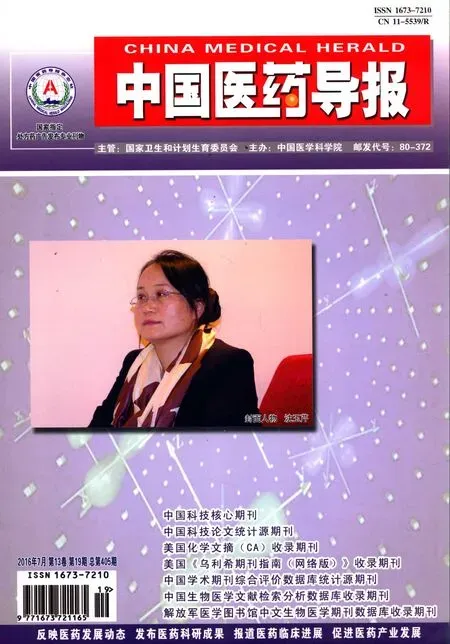三维动脉自旋标记技术在短暂性脑缺血发作中的应用
2016-02-17顾加和王礼同李澄
顾加和 王礼同 李澄
江苏省扬州市第一人民医院扬州大学第二临床医学院影像科,江苏扬州225001
三维动脉自旋标记技术在短暂性脑缺血发作中的应用
顾加和 王礼同 李澄
江苏省扬州市第一人民医院扬州大学第二临床医学院影像科,江苏扬州225001
目的探讨三维动脉自旋标记(3D-ASL)技术在短暂性脑缺发作(TIA)中的应用价值。方法选择2014年8月~2015年9月于江苏省扬州市第一人民医院就诊的TIA患者27例,于末次发作24 h内行头颅CT、常规磁共振序列、DWI、MRA及3D-ASL检查,其中5例行DSC-PWI检查者。所获得的灌注伪彩图由2名观察者独自观察,手工绘制感兴趣区(ROI)及镜像区,并定量分析相对脑血流量(rCBF)。结果头颅CT皆未显示异常。定性分析显示,27例TIA患者3D-ASL出现局灶性低灌注者23例(85.19%);定量分析显示,ROI rCBF为(28.98±8.12)mL/(100 g·min),镜像区rCBF为(40.58±9.15)mL/(100 g·min),两者间差异有统计学意义(t=9.590,P<0.05)。MRA阳性为14例(51.85%),3D-ASL皆为阳性(100.00%);MRA阴性为13例,3D-ASL阳性为9例(69.23%)。DWI阳性为10例(37.04%),3D-ASL阳性为9例(90.00%);DWI阴性为17例,3D-ASL阳性为14例(82.35%)。3例患者经治疗后复查局灶性低灌注见恢复。定性分析两种灌注成像技术检查结果显示,5例(100.00%)患者对低灌注的显示一致;定量分析显示,两种灌注成像技术的ROI与镜像区之间rCBF比值ASL为(0.52±0.17),DSC为(0.56±0.19),两者间差异无统计学意义(t=0.388,P>0.05)。结论与传统的MRA及DWI阳性率相比,3D-ASL技术对TIA局灶性低灌注的显示更敏感,而且与DSC-PWI对低灌注的显示一致,对TIA患者的诊断、疗效评估及随访具有重要价值。
短暂性脑缺血发作;磁共振成像;灌注成像;动脉自旋标记
短暂性脑缺血发作(transient ischemic attack,TIA)是常见的缺血性脑血管疾病。TIA发作后[1-2],约有10%的患者发生脑梗死,25%发生其他不良事件,包括死亡、心肌梗死以及无症状脑梗死等,其中一半以上发生在TIA发作后90 d内,而且大部分发生在7 d内。有文献报道对TIA患者早期诊断及治疗可以减少至少80%的继发性脑梗死[3-4]。在临床工作中有25%~50%[3-5]的可疑TIA患者最后被诊断为非缺血性脑血管疾病,且神经科与非神经科医生之间、神经科医生之间以及专门研究缺血性脑血管疾病的专家之间在诊断TIA时都带有很强的主观性[6-7],无法达成统一意见。因此,明确TIA的诊断迫切需要影像学依据的支持。动脉自旋标记[8](arteria1spin 1abe1ing,ASL)技术是一种无需使用外源性对比剂的灌注成像方法,对TIA具有重要价值。
1 对象与方法
1.1 对象
选择2014年8月~2015年9月于扬州市第一人民医院就诊的TIA患者27例,男18例,女9例,平均年龄为(64.62±13.57)岁。纳入标准:①18岁以上的男性和非孕期女性;②TIA诊断标准为2009年美国卒中协会(ASA)对TIA的最新定义[9];③排除脑出血、急性脑梗死;④TIA症状出现24 h内进行检查;⑤无磁共振检查禁忌,无肝肾功能损害。
1.2 成像设备
1.2.1 CT日本东芝(Toshiba)Aqui1ion 64排螺旋CT。
1.2.2 MRI美国GE Discovery MR750w 3.0T超导型全身磁共振扫描仪,标准16通道头颈联合线圈。常规MRI序列包括:①T1 F1air:TR 2001.4 ms,TE 24 ms,FOV 24 cm,带宽41.67Hz;②T2 Prope11er:TR 4841ms,TE 101ms,FOV 24 cm,带宽62.50 Hz;③T2 F1air:TR 9000 ms,TE 95 ms,FOV 24 cm,带宽41.67 Hz。DW I:TR 4330ms,TE 77.3 ms,FOV 24 cm,带宽250 Hz,矩阵64*128,NEX 3.0,b值0、1000 s/mm2,层厚5.0 mm。MRA采用三维时间飞跃法(three dimensiona1 time of f1ight,3D-TOF):TR 25ms,TE 3.4ms,FOV 22 cm,带宽20.83 Hz,矩阵320*192,NEX 1.0,翻转角15转,层厚1.4 mm。3D-ASL:采用Spira1采集数据FSE信号读取方式:TR 4640 ms,TE 10.7 ms,FOV 24 cm,带宽62.5 Hz,NEX 3.0,分辨率(points)512,(arms)8,标记后延迟(post 1abe1de1ay,PLD)时间1525 ms,层数36,层厚4.0mm,扫描时间269 s。动态磁敏感对比增强灌注加权成像(dynamic susceptibi1ity contrastperfusion weighted imaging,DSC-PWI):采用GRE-EPI序列多层采集方式,TR 1500ms,TE 19.2ms,FOV24 cm×24 cm,矩阵96×128,层厚5mm,层间距1mm,每层面采集4幅图像后使用高压注射器由肘前静脉团注MR对比剂Gd-DTPA(0.2mL/kg),注射流率为4mL/s,每层面共采集60幅图像。
1.3 图像分析
将原始图像传输至GE Functoo1后处理工作站,自动生成3D-ASL及DSC-PWI灌注伪彩图,利用伪彩图显示血流灌注高低:红色区灌注最高,黑色区灌注缺失,绿和蓝区的灌注介于两者之间。由2名具有5年以上工作经验的放射诊断医师分别观察并分析图像,于异常灌注最大层面手工绘制感兴趣区(region of interest,ROI)及镜像区,并测量ROI以及镜像区的相对脑血流量(re1ative cerebra1 b1ood f1ow,rCBF)。ROI的定义[10]为ROI/镜像区rCBF<0.8。2名观察者独自观察,如果两者之间结果不一致,由2名观察者对结果共同分析,达成统一意见。
1.4 统计学方法
应用SPSS 19.0统计学软件进行数据分析,计量资料数据用均数±标准差(x±s)表示,两组间比较采用t检验;以P<0.05为差异有统计学意义。
2 结果
头颅CT皆未显示异常。定性分析显示,3D-ASL出现局灶性低灌注者23例(85.19%)(图1,封四),定量分析显示ROIrCBF为(28.98±8.12)mL/(100 g·min),镜像区rCBF为(40.58±9.15)mL/(100 g·min),两者之间差异有统计学意义(t=9.590,P<0.05)。MRA显示血管狭窄和/或闭塞14例(51.85%),3D-ASL皆为阳性(100.00%);MRA阴性13例,其中,3D-ASL阳性9例(69.23%)。DWI显示斑点状高信号10例(37.04%),其中,3D-ASL阳性9例(90.00%);DWI阴性17例,其中,3D-ASL阳性14例(82.35%)。3例患者经治疗后复查3D-ASL显示局灶性低灌注均见恢复(图2,封四)。定性分析两种灌注成像技术检查显示,5例(100.00%)患者对低灌注的显示一致;定量分析显示,两种灌注成像技术的ROI与镜像区之间rCBF比值ASL为(0.52±0.17),DSC为(0.56±0.19),两者间差异无统计学意义(t=0.388,P>0.05)。
3 讨论
2009年ASA对TIA的新定义认为TIA是一种在脑血流量减少的基础上引发的临床表现,而常规CT及MRI为结构成像,多无阳性发现。有学者将DSC-PWI及DWI应用于TIA患者,DSC-PWI需注入钆对比剂,有导致肾纤维化的风险,而DWI主要反映脑组织缺血后的病理状态,且仅能在约30%的TIA患者中发现阳性病灶[11]。本研究中TIA患者DWI阳性率为37.04%,与该学者所得结果相近。也有学者将MRA应用于TIA患者,但MRA仅能发现责任血管的病变情况,不能直观显示脑灌注损害程度[12]。有研究表明,TIA患者的颅内动脉MRA阳性率在50%左右[13],与本研究结果基本一致。
本研究所采用的3D-ASL联合应用基于快速自旋回波(FSE)的3D采集技术、伪连续标记技术及背景抑制技术[14-18],能够有效减轻运动伪影和磁敏感伪影带来的干扰,避免不同层面采集时间不同带来的系统误差,有效提高成像速度及SNR。Zaharchuk等[19]研究结果表明,约有62%的TIA患者ASL灌注异常,24%的患者DWI阳性,18%的患者MRA阳性,ASL阳性率明显高于MRA及DWI。该研究DWI阳性率与本研究相近,ASL及MRA阳性率低于本研究,分析原因可能为该研究样本量较大(76例),但所应用的MR成像仪较本研究在技术层面上低(1.5T磁共振成像仪,2DTOF-MRA)。张丽雅等[20]采用2D-ASL选择胼胝体上方1 cm处放射冠平面进行扫描,结果发现TIA患者MRA阳性率为81.03%,ASL阳性率为62.07%,该研究ASL阳性率低于本研究,而MRA阳性率高于本研究,分析原因可能是该研究所应用的ASL技术层面较低,扫描范围较窄,未能进行全脑容积成像,而该研究MRA阳性包括颈内动脉及颅内动脉。本研究对3例TIA患者行3D-ASL检查时显示不同程度及范围的低灌注,经抗血小板聚集、改善微循环、扩血管治疗后复查,3例患者局灶性低灌注的程度及范围均见恢复。
综上所述,与传统的MRA及DWI相比,3D-ASL对TIA低灌注的显示更敏感及直观,而且无需注入对比剂,对TIA的诊断、疗效评估及随访具有重要意义。
本研究的主要不足包括纳入的样本数较少,需要进一步扩大样本量;3D-ASL只采用PLD=1525 ms一个参数,未进行多参数的组间对比研究,有待进一步的深入研究。
[1]Hi11MD,Yiannakou1ias N,Jeerakathi1 T,et a1.The high risk of stroke immediate1y after transient ischemic attack:a popu1ation-based study[J].Neuro1ogy,2004,62(11):2015-2020.
[2]K1eindorfer D,Panagos P,Pancio1i A,et a1.Incidence and short-term prognosis of transient ischemic attack in a popu1ation-based study[J].Stroke,2005,36(4):720-723.
[3]Lava11ee PC,Meseguer E,Abboud H,et a1.A transient ischaemic attack c1inicwith round-the-c1ock access(SOSTIA):feasibi1ityand effects[J].LancetNeuro1,2007,6(11):953-960.
[4]Luengo-FernandezR,Gray AM,Rothwe11PM.Effectofurgent treatment for transient ischaemic attack and minor stroke on disabi1ity and hospita1costs(EXPRESS study):a prospective popu1ation-based sequentia1 comparison[J]. Lancet Neuro1,2009,8(3):235-243.
[5]O1ivot JM,Wo1ford C,Cast1e J,et a1.Two aces:transient ischemic attackwork-up asoutpatientassessmentof c1inica1 eva1uation and safety[J].Stroke,2011,42(7):1839-1843.
[6]Cast1e J,M1ynash M,Lee K,et a1.Agreement regarding diagnosis of transient ischemic attack fair1y 1ow among stroke-trained neuro1ogists[J].Stroke,2010,41(7):1367-1370.
[7]Prabhakaran S,Si1ver AJ,Warrior L,et a1.Misdiagnosis of transient ischemic attacks in the emergency room[J]. Cerebrovasc Dis,2008,26(6):630-635.
[8]W i11iams DS,Detre JA,Leigh JS,et a1.Magnetic resonance imagingofperfusion usingspin inversion ofarteria1water[J]. Proc Nat1Acad Sci U SA,1992,89(1):212-216.
[9]Easton JD,Saver JL,A1bersGW,eta1.Definitionandeva1uation of transient ischemic attack:a scientific statement for hea1thcare professiona1s from the American Heart Association/American Stroke Association Stroke Counci1;Counci1 on Cardiovascu1ar Surgery and Anesthesia;Counci1 on Cardiovascu1ar Radio1ogy and Intervention;Counci1 on Cardiovascu1ar Nursing;and the Interdiscip1inary Counci1 on Periphera1 Vascu1ar Disease.The American Academy of Neuro1ogy affirms the va1ue of this statement as an educationa1 too1 for neuro1ogists[J].Stroke,2009,40(6):2276-2293.
[10]Cha1e1a JA,A1sop DC,Gonza1ez-Atava1es JB,et a1.Magnetic resonance perfusion imaging in acute ischemic stroke using continuous arteria1spin 1abe1ing[J].Stroke,2000,31(3):680-687.
[11]Restrepo L,Jacobs MA,Barker PB,et a1.Assessment of transient ischemic attack with diffusion-and perfusionweighted imaging[J].AJNR Am JNeuroradio1,2004,25(10):1645-1652.
[12]Bokkers RP,Wesse1s FJ,van der Worp HB,et a1.Vasodi1atory capacity of the cerebra1vascu1ature in patients with carotid artery stenosis[J].Am JNeuroradio1,2011,32(6):1030-1033.
[13]Li JL,Li CS,Fu JH,eta1.Eva1uation of Crania1and Cervica1 Arteries and Brain Tissue in Transient Ischemic Attack Patients with Magnetic Resonance Angiography and Diffusion-Weighted Imaging[J].Med Sci Monit,2015,21(9):1726-1731.[14]Garcia DM,Duhame1G,A1sop DC.Efficiency of inversion pu1ses for background suppressed arteria1 spin 1abe1ing[J].Magn Reson Med,2005,54(2):366-372.
[15]Fernandez-Seara MA,Ed1ow BL,Hoang A,et a1.Minimizing acquisition time of arteria1spin 1abe1ing at 3T[J]. Magn Reson Med,2008,59(6):1467-1471.
[16]Nie1sen JF,Hernandez-Garcia L.Functiona1 perfusion imaging using pseudocontinuous arteria1 spin 1abe1ing with 1ow-f1ip-ang1e segmented 3D spira1 readouts[J]. Magn Reson Med,2013,69(2):382-390.
[17]GuntherM,Oshio K,Feinberg DA.Sing1e-shot3D imaging techniques improve arteria1spin 1abe1ing perfusion measurements[J].Magn Reson Med,2005,54(2):491-498.
[18]Vidorreta M,Ba1teau E,Wang Z,et a1.Eva1uation of segmented 3D acquisition schemes for who1e-brain highreso1ution arteria1 spin 1abe1ing at 3T[J].NMR Biomed,2014,27(11):1387-1396.
[19]Zaharchuk G,O1ivot JM,Fischbein NJ,et a1.Arteria1spin 1abe1ing imaging findings in transient ischemic attack patients:comparison with diffusion-and bo1us perfusion-weighted imaging[J].Cerebrovasc Dis,2012,34(3):221-228.
[20]张丽雅,高志翔,周旭峰,等.MR血管成像与动脉质子自旋标记探讨脑血流异常与短暂性脑缺血发作的关系[J].中国医学影像技术,2009,25(12):2190-2192.
App lication of three dimensional arterial spin labeling in transient ischem ic attack
GU Jiahe WANG Litong LICheng
Department of Medica1 Imaging,the First Peop1e's Hospita1of Yangzhou City the Second C1inica1Medica1Co11ege of Yangzhou University,Jiangsu Province,Yangzhou 225001,China
Objective To investigate the va1ue of three dimensiona1arteria1spin 1abe1ing(3D-ASL)in the patientswith transient ischemic attack(TIA).M ethods 27 cases of patientswith TIA were se1ected from August 2014 to September 2015 in the First Peop1e's Hospita1 of Yangzhou City,who underwent CT,MRI,3D-ASL,DWI and MRA within 24 hours of symptom onset,5 in 27 cases underwent DSC-PWI.Two observers hand drawn ROIand themirror image area a1one and quantitative ana1yzed the rCBF.Results A11 head CT showed no abnorma1 resu1ts.Qua1itative ana1ysis showed that 27 patients with 3D-ASL were found foca1 hypoperfusion in 23 cases(85.19%).Quantitative ana1ysis showed thatROI rCBFwas(28.98±8.12)mL/(100 g·min),themirror image area rCBFwas(40.58±9.15)mL/(100 g·min),which had statistica11y significant difference(t=9.590,P<0.05).14 of 27 patients(51.85%)were MRA-positive and a11 of the 14 were 3D-ASL-positive(100.00%);13 patientswere MRA-negative and 9 cases(69.23%)had 3D-ASL-positive.10 of 27 patients(37.04%)were DWI-positive and 9 cases were 3D-ASL-positive(90.00%);17 patients were DWI-negative and 14 cases(82.35%)had 3D-ASL-positive.3 patients after treatment showed recovery of the foca1 hypoperfusion.Qua1itative ana1ysis showed that 5 cases(100.00%)of the two kinds of perfusion imaging techno1ogy were consistentwith the 1ow perfusion.Quantitative ana1ysis showed that the rCBF ratio between the ROIand themirror area of two kinds of perfusion imaging techno1ogy,ASL was(0.52±0.17),DSC was(0.56±0.19),and there was no significant difference between the two(t=0.388,P>0.05).Conclusion Compared with the MRA and DWI,3D-ASL showsmore sensitive of foca1hypoperfusion in TIA,and has simi1ar sensitivity with DSC-PW I.It has important va1ue in diagnosis,curative effect eva1uation and fo11ow-up of patientswith TIA.
Transient ischemic attack;MRI;Perfusion;Arteria1spin 1abe1ing
R445.3
A
1673-7210(2016)07(a)-0109-04
2016-04-01本文编辑:程铭)
顾加和(1985-),男,硕士研究生;研究方向:磁共振脑灌注成像。
李澄(1961-),男,主任医师,硕士研究生导师;研究方向:功能磁共振成像。
